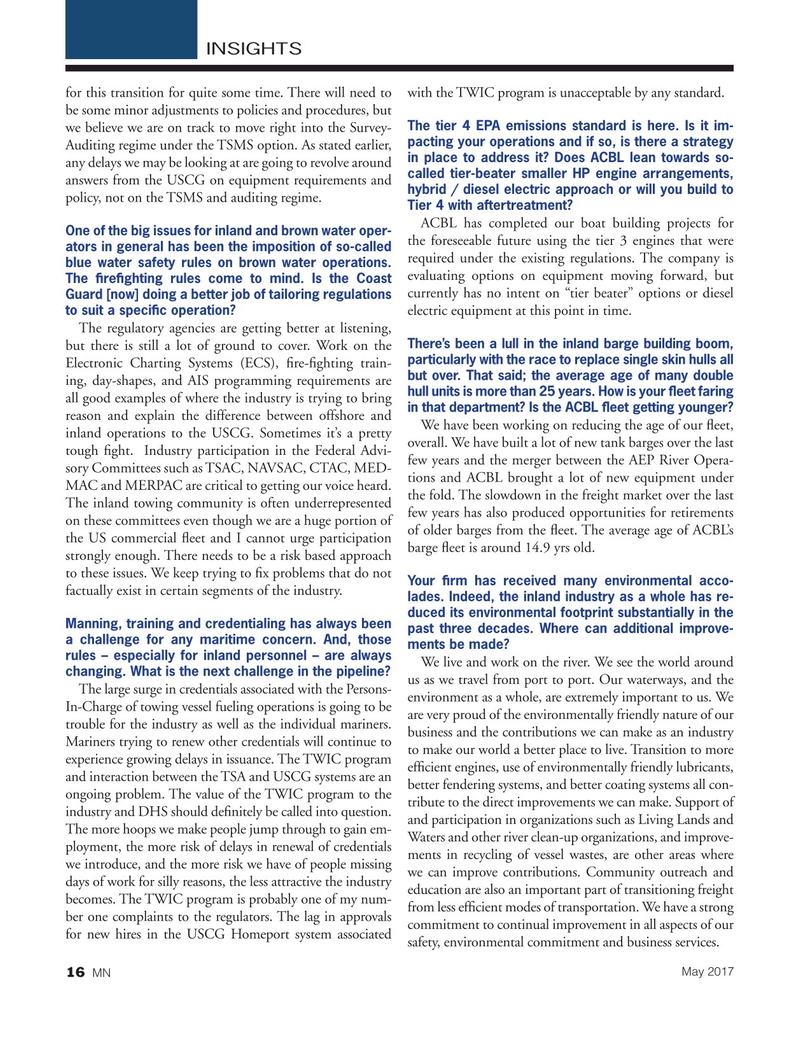
Page 16: of Marine News Magazine (May 2017)
Inland Waterways
Read this page in Pdf, Flash or Html5 edition of May 2017 Marine News Magazine
INSIGHTS for this transition for quite some time. There will need to with the TWIC program is unacceptable by any standard.
be some minor adjustments to policies and procedures, but
The tier 4 EPA emissions standard is here. Is it im- we believe we are on track to move right into the Survey- pacting your operations and if so, is there a strategy
Auditing regime under the TSMS option. As stated earlier, in place to address it? Does ACBL lean towards so- any delays we may be looking at are going to revolve around called tier-beater smaller HP engine arrangements, answers from the USCG on equipment requirements and hybrid / diesel electric approach or will you build to policy, not on the TSMS and auditing regime.
Tier 4 with aftertreatment?
ACBL has completed our boat building projects for
One of the big issues for inland and brown water oper- the foreseeable future using the tier 3 engines that were ators in general has been the imposition of so-called required under the existing regulations. The company is blue water safety rules on brown water operations. evaluating options on equipment moving forward, but
The ? re? ghting rules come to mind. Is the Coast currently has no intent on “tier beater” options or diesel
Guard [now] doing a better job of tailoring regulations to suit a speci? c operation?
electric equipment at this point in time.
The regulatory agencies are getting better at listening,
There’s been a lull in the inland barge building boom, but there is still a lot of ground to cover. Work on the particularly with the race to replace single skin hulls all
Electronic Charting Systems (ECS), ? re-? ghting train- but over. That said; the average age of many double ing, day-shapes, and AIS programming requirements are hull units is more than 25 years. How is your ? eet faring all good examples of where the industry is trying to bring in that department? Is the ACBL ? eet getting younger?
reason and explain the difference between offshore and
We have been working on reducing the age of our ? eet, inland operations to the USCG. Sometimes it’s a pretty overall. We have built a lot of new tank barges over the last tough ? ght. Industry participation in the Federal Advi- few years and the merger between the AEP River Opera- sory Committees such as TSAC, NAVSAC, CTAC, MED- tions and ACBL brought a lot of new equipment under
MAC and MERPAC are critical to getting our voice heard.
The inland towing community is often underrepresented the fold. The slowdown in the freight market over the last few years has also produced opportunities for retirements on these committees even though we are a huge portion of the US commercial ? eet and I cannot urge participation of older barges from the ? eet. The average age of ACBL’s strongly enough. There needs to be a risk based approach barge ? eet is around 14.9 yrs old.
to these issues. We keep trying to ? x problems that do not
Your ? rm has received many environmental acco- factually exist in certain segments of the industry.
lades. Indeed, the inland industry as a whole has re- duced its environmental footprint substantially in the
Manning, training and credentialing has always been past three decades. Where can additional improve- a challenge for any maritime concern. And, those ments be made?
rules – especially for inland personnel – are always
We live and work on the river. We see the world around changing. What is the next challenge in the pipeline?
us as we travel from port to port. Our waterways, and the
The large surge in credentials associated with the Persons- environment as a whole, are extremely important to us. We
In-Charge of towing vessel fueling operations is going to be are very proud of the environmentally friendly nature of our trouble for the industry as well as the individual mariners. business and the contributions we can make as an industry
Mariners trying to renew other credentials will continue to to make our world a better place to live. Transition to more experience growing delays in issuance. The TWIC program ef? cient engines, use of environmentally friendly lubricants, and interaction between the TSA and USCG systems are an better fendering systems, and better coating systems all con- ongoing problem. The value of the TWIC program to the tribute to the direct improvements we can make. Support of industry and DHS should de? nitely be called into question. and participation in organizations such as Living Lands and
The more hoops we make people jump through to gain em-
Waters and other river clean-up organizations, and improve- ployment, the more risk of delays in renewal of credentials ments in recycling of vessel wastes, are other areas where we introduce, and the more risk we have of people missing we can improve contributions. Community outreach and days of work for silly reasons, the less attractive the industry education are also an important part of transitioning freight becomes. The TWIC program is probably one of my num- from less ef? cient modes of transportation. We have a strong ber one complaints to the regulators. The lag in approvals commitment to continual improvement in all aspects of our for new hires in the USCG Homeport system associated safety, environmental commitment and business services.
May 2017
MN 16

 15
15

 17
17
